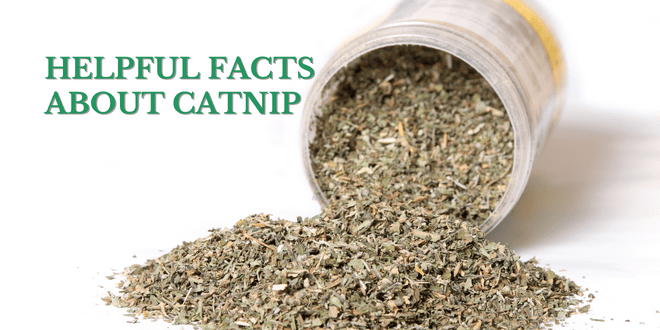
Catnip is something many cat parents still don’t understand. I’ve seen some people overdo when offering to cats and others who never give their cats the chance to enjoy this fun experience. Here’s a list of some interesting facts about catnip:
Appearance
- Catnip is a perennial belonging to the mint family.
- It’s a plant native to Europe that was imported to the United States and other countries.
- In appearance, the plant can grow to about 2-3 feet tall and has heart-shaped leaves.
- The blooms can be lavender, white, or pink.
- If grown outdoors, it can quickly take over your garden, not to mention the fact that it’ll attract the neighborhood cats to your yard.
- Catnip products come in many forms – fresh, dried, sprays, catnip-filled toys, chew products, scratching posts, etc.
- Since the quality of catnip can vary, it’s best to buy good quality, organic catnip free from pesticides and fillers.
The Catnip Response
- Nepetalactone is the chemical in catnip that causes the response.
- It creates a feeling of euphoria, similar to the effect of a hallucinogenic drug but without any addictive or harmful effects.
- The catnip response is inherited.
- It’s estimated that about 30% of cats lack this gene.
- Kittens and elderly cats don’t typically respond to catnip, and in fact, young kittens may actually be repelled by it.
- Even big cats, such as tigers, respond to catnip.
- The catnip response lasts about 10-15 minutes.
- It takes about 1-2 hours for the behavior to reset before a cat is capable of reacting to the herb again.
- Cats react to catnip through inhalation.
- Cats also use their vomeronasal organ (Jacobson’s organ) to analyze the scent.
- Inhaled catnip has a stimulating and euphoric effect whereas ingested catnip has a calming effect.
- When exposed to catnip, cats tend to sniff, roll, lick, and even eat the herb. All of this is totally normal and harmless.
Unexpected Reactions
There are some cats who become aggressive when exposed to catnip. In a multicat household, it’s best to first test a cat’s response by offering the herb to each one individually so you can gauge reactions. If you find out one cat gets a bit aggressive, offer that kitty catnip in a separate location and then wait until the effect has totally worn off before reuniting him with his feline companions.
A Behavior Tool
- Catnip can be used to help entice a sedentary or depressed cat to engage in playtime.
- Rub catnip on the scratching post to encourage your cat to rediscover the benefits of scratching in appropriate places.
- Catnip can be used in veterinary clinics, shelters, and foster homes in addition to the cat’s own home to help lower stress levels.
How to Offer Catnip to Your Cat
- Catnip should only be offered a maximum of two or three times a week. If cats are constantly exposed to it they can lose their ability to respond.
- The volatile oil, nepetalactone, needs to be released in the dried form of the herb before offering it to your cat. Rub the dried leaves between your fingers to release it.
- You can find cat toys in your local pet supply store that have resealable pouches for filling with catnip. This is a better option than buying pre-filled toys that may be filled with poor quality catnip.
- Catnip can be offered in toys, rubbed on toys, loose, rubbed on scratching posts, or you can even just place some in a knotted sock.
Buying and Storage
- Keep catnip in a container with a tight-fitting lid kept totally out of a cat’s reach to avoid unplanned self-serve catnip parties.
- If you grow your own catnip you can offer the fresh leaves to your cat. You can also dry it by hanging the harvested plant upside down to dry and then store in an airtight container.
- When purchasing loose catnip, look for organic brands that don’t include many stems. The more leaves and blossoms, the more potent the catnip.
Need More Information?
For more information on cat behavior and training, refer to the books by Pam Johnson-Bennett. Pam’s books are available in bookstores and online. We’ve included links to Amazon here on our website.
If you have a question about your cat’s health, contact your veterinarian. This article is not intended as a medical diagnosis nor is it a replacement for your cat’s regular veterinary care. This article is for general information purposes only.
 Problem Solving & Advice by Pam Johnson-Bennett Cat Behavior Expert & Best-selling Author
Problem Solving & Advice by Pam Johnson-Bennett Cat Behavior Expert & Best-selling Author



